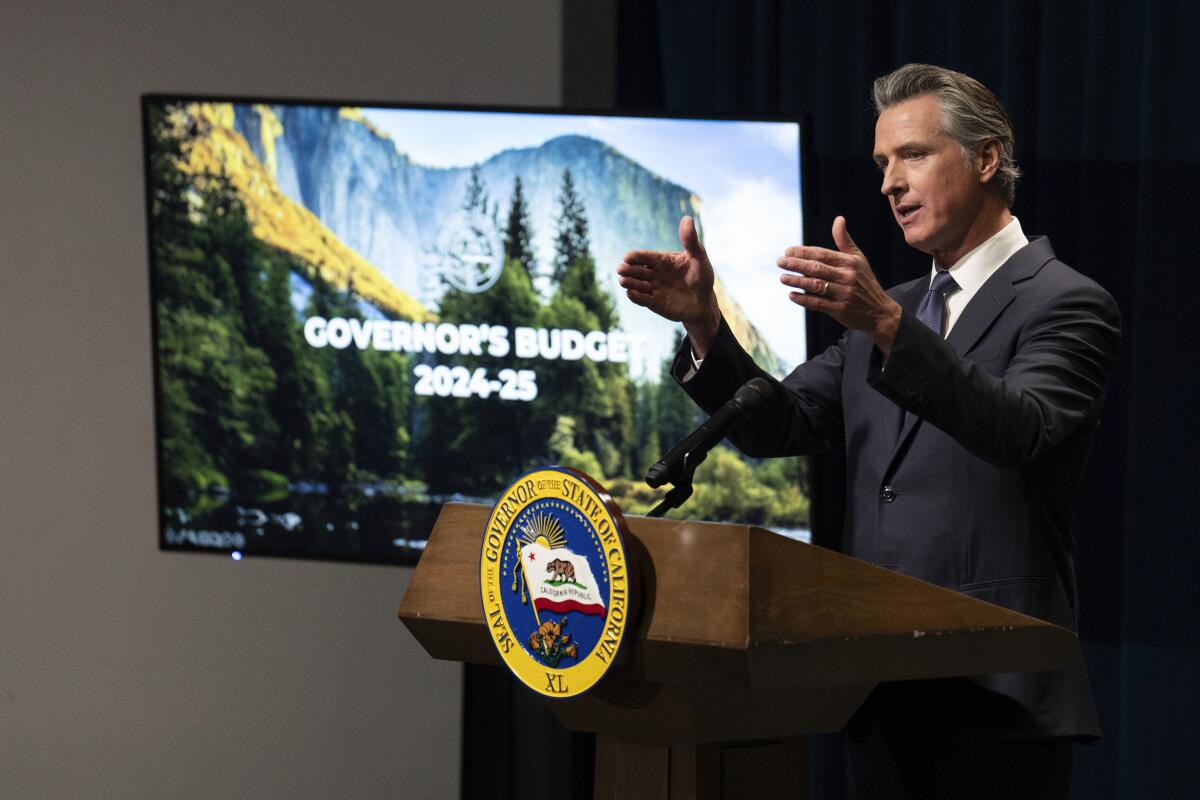California in a jam after borrowing billions to pay unemployment benefits

California’s massive budget deficit, coupled with the state’s relatively high level of joblessness, has become a major barrier to reducing the billions of dollars of debt it has incurred to pay unemployment benefits.
The surge in unemployment brought on by the COVID-19 pandemic pushed the state’s unemployment insurance trust into insolvency. And over the last year California’s joblessness has been on the upswing again, reaching 5.3% in February, the highest among all states. The March job numbers come out Friday.
To keep the safety-net program operating at a time when the taxes paid by employers and earmarked for jobless benefits are insufficient, Sacramento has been borrowing billions of dollars from the federal government. The debt now stands at about $21 billion and growing, an increasing burden for state deficit fighters and for the businesses that pay into the jobless insurance program.
Payroll taxes paid by employers are rising not only to cover payouts to unemployed workers but also a state surcharge and a gradually increasing federal surtax to help pay off the principal on the debt. But the tax increases are not enough to deal with the huge loan the state has incurred, or at least not in any timely manner.
California already has paid more than $650 million in interest on the loan — and about $550 million more is due Sept. 30.
“Businesses are going to continue to see the slow boil eating into their margins,” said Robert Moutrie, senior policy advocate for the California Chamber of Commerce.
Higher taxes will hit small and midsize companies in sectors such as restaurants and tourism especially hard, he said.
“It just adds to the burden and the costs of operating here and makes companies look at operating elsewhere,” Moutrie said.
Although the pandemic is largely to blame for California’s huge unemployment insurance debt — and there’s been a lot of attention on dollars lost to fraud — analysts and workers’ rights groups point to another problem: Even during more-normal economic times, the state often doesn’t collect enough unemployment insurance taxes to cover jobless claims.
“The root problem really is that for decades policymakers haven’t been requiring businesses to pay enough into the [unemployment insurance] fund to support the benefits workers really need,” said Amy Traub, senior researcher and policy analyst at the National Employment Law Project.
“So there’s a structural deficit that underlies this crisis moment with this huge debt to the federal government.”
Data also show that jobless workers in California stay on unemployment significantly longer than the national average, which adds to the total payout amount. And California workers claim unemployment benefits in disproportionately high numbers.
The state accounts for about 20% of the nation’s jobless claims, far in excess of its 11% share of the labor force population. That partly reflects the state’s higher unemployment and accompanying increases in layoffs and jobless claims in the tech industry and other sectors, but also its comparatively easier eligibility rules and low re-employment rate.
Last year California’s jobless workers received on average $385 a week, replacing only about 28% of the average wage. Both figures are lower than the national averages, according to Department of Labor statistics. (The wage replacement rate is about 50% for minimum-wage workers in California.)
From surplus to deficit
But California also stands out as an outlier in the way it has managed, or mismanaged, the program.
When COVID struck in March 2020, U.S. unemployment jumped to 14.8% a month later and brought unprecedented jobless claims, forcing California and many other states to borrow from the federal government to keep paying benefits. Almost all the other states have since repaid those loans, some with pandemic relief money they also got from Washington.
Today only New York and California, plus the Virgin Islands, still owe money for unemployment insurance loans.
Analysts said California could have used some of the $43.5 billion the state received from the American Rescue Plan Act to pay down the debt. Instead, state officials spent the relief money for other purposes, including additional stimulus checks to residents.
“California had options and it chose the spending option instead of the responsible option,” said Matt Weidinger, a senior fellow at the American Enterprise Institute who has written widely on the unemployment insurance program. He said higher employer payroll taxes will ultimately spill over to employees in the form of less wages.
“California distributed relief during a time when people and businesses were struggling, everything from covering rent and utility bills to small business grants — helping those hardest hit by the pandemic while stimulating the economy,” said Alex Stack, a spokesman for Gov. Gavin Newsom’s office. “That’s on top of paying down $250 million of unemployment fund debts.”
State legislative analysts were careful not to criticize policy choices made during the extraordinarily uncertain times.
Some suggested, however, that officials may have felt the state had plenty of financial cushion coming out of the pandemic in 2021-22. Then, Sacramento was flush with cash, thanks to huge tax windfalls. And the interest rate on the federal unemployment insurance loan two years ago was at a historical low of 1.6%.
But the interest rate on the loan has since risen to 2.6% — and may yet rise further. What’s more, once huge surpluses are now a projected record budget deficit of more than $70 billion in 2024-25, according to a February update by California’s Legislative Analyst Office.
An economic downturn in the state, marked by a falloff in technology investment and rising overall unemployment, has resulted in unprecedented shortfalls in tax revenues.
Under such budget constraints, California officials had little choice but to pull back on plans to spend $1 billion to reduce the principal on the unemployment insurance loan.
What’s the solution?
California’s Employment Development Department, which oversees the state’s unemployment insurance program, has said that it would rely on increased federal taxes on employers to pay down the debt.
Currently California employers pay a federal unemployment insurance tax of 1.2% on the first $7,000 of wages per employee, but that will rise incrementally every year so long as California is in debt, to more than 3.5% after 10 years. And analysts estimate that it may take at least that long to pay off the debt.
Businesses also pay a state unemployment insurance tax, also on the first $7,000 of wages, based on their layoff history, plus a surcharge when there’s a shortfall in the jobless benefits fund.
Combining both state and federal portions, a new California employer, for example, would be looking at paying about $500 in unemployment insurance taxes per employee this year — almost double than during normal times.
“California’s apparent plan to rely on [federal tax] revenue to pay off the loan avoids addressing solvency in the state unemployment insurance law and places the burden of increased unemployment benefits during the pandemic on employers,” said Doug Holmes, former director of Ohio’s unemployment insurance program and currently president of the consulting firm UWC.
In California, business groups say it’s unfair for employers to shoulder the increasing burden when they weren’t responsible for the pandemic or the temporary lockdowns that were imposed on them, resulting in layoffs and higher unemployment claims. They argue that it will only add to the state’s already higher business costs that have pushed some California companies to relocate to Texas, Nevada and other states.
Traub, of the National Employment Law Project, said employers have to pay more to make the math work and ensure the unemployment trust system is sustainable over the long haul.
Sacramento collects unemployment insurance taxes on the first $7,000 of wages per employee per year. Traub noted that most other states have a significantly higher taxable wage limit — New York at $12,500; New Mexico at $31,700; and Washington state, the highest, at $68,500.
“Raising the taxable wage base has got to be part of the solution,” Traub said.
California legislators are now considering an increase, which many agree is needed. “That’s very reasonable,” said Michael Bernick, an employment attorney at Duane Morris in San Francisco.
Bernick was the EDD director in the early 2000s when, under Gov. Gray Davis, the state raised the maximum weekly unemployment benefits to $450 a week — but without increasing the taxes to cover the larger payments.
Writing in a report with Holmes, Bernick recommended a number of steps the EDD could take to shore up the state’s unemployment benefits program, including tightening eligibility standards and modernizing the agency’s computer and communications systems. But by far the main policy change that’s needed is to help jobless workers move into new jobs more rapidly.
In 2022, California workers stayed on unemployment aid for an average of 18.1 weeks, compared with 14.5 weeks nationally, according to a study by the Department of Labor’s former lead actuary, Robert Pavosevich.
In California that year, 47% of recipients took the full maximum 26 weeks of jobless benefits. Nationally, only 27% exhausted all benefit weeks available.
“Those are striking numbers and highlight just how much the system needs to be reshaped,” Bernick said. “How do we get people back to work quickly? It’s both good for businesses and the workers, but also for the unemployment fund.”
More to Read
Inside the business of entertainment
The Wide Shot brings you news, analysis and insights on everything from streaming wars to production — and what it all means for the future.
You may occasionally receive promotional content from the Los Angeles Times.











